Introduction
The American Studio Glass movement is a vibrant tapestry of art, craftsmanship, and innovation. It’s a community where artists push the boundaries of what’s possible with glass, creating pieces that are not just visually stunning but also deeply meaningful. For some of us, the journey through the world of hot glass has been transformative, leading us down the path of healing arts. Now, as we circle back to our roots in hot glass, it’s time to explore how this art form has shaped our shamanic view of the world.
In this article, we’ll focus on a handful of remarkable artists whose work has been a guiding light in our spiritual and artistic endeavors. We’ll start with Dale Chihuly and William Morris, pioneers in the field, and then move on to Preston Singletary, a voice for indigenous arts. Along the way, we’ll touch upon the Venetian influences that have enriched American glass art, including Lino Tagliapeitra, William Gudenrath, Dante Marioni, and Eric Meek, and we’ll also highlight educational opportunities for aspiring glass artists.
Dale Chihuly – Visionary Artist
Dale Chihuly, an iconic figure in the American Studio Glass movement, is renowned for revolutionizing the perception and presentation of glass art. Born in 1941 in Tacoma, Washington, Chihuly’s bold and innovative approach has made him one of the most celebrated glass artists in the world. His work is characterized by vibrant colors, dramatic shapes, and grand scale, pushing the boundaries of the medium far beyond traditional confines.
Chihuly’s journey in glass art began in the 1960s, and he quickly distinguished himself with his unique approach to glassblowing. His education at the University of Washington, the Rhode Island School of Design, and the Venini glass factory in Venice played a pivotal role in shaping his artistic vision. It was in Venice where he observed the team approach to glassblowing, which greatly influenced his future work. This collaborative method allowed Chihuly to create larger, more complex pieces than had previously been possible in studio glass.
The Impact of Dale Chihuly
In the 1970s, Chihuly co-founded the Pilchuck Glass School in Washington State, which has since become a prominent center for glass art education. His influence as an educator and mentor has been profound, nurturing a generation of glass artists who continue to expand the field. Chihuly’s own work, meanwhile, has been featured in over 200 museum collections worldwide, and his large-scale installations and public artworks have captivated audiences globally.
Chihuly’s significance in the American Studio Glass movement lies not only in his artistic creations but also in his ability to bring glass art into the public eye. His installations are often displayed in gardens, conservatories, and public spaces, making them accessible to a broad audience. This public presence has played a crucial role in elevating glass art from the confines of galleries and museums into the realm of public and community art.
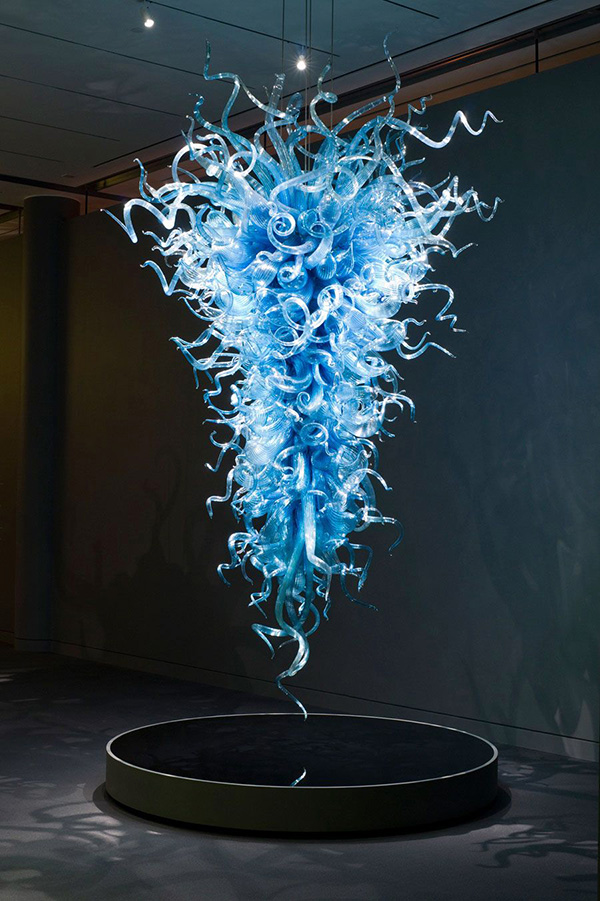
Dale Chihuly
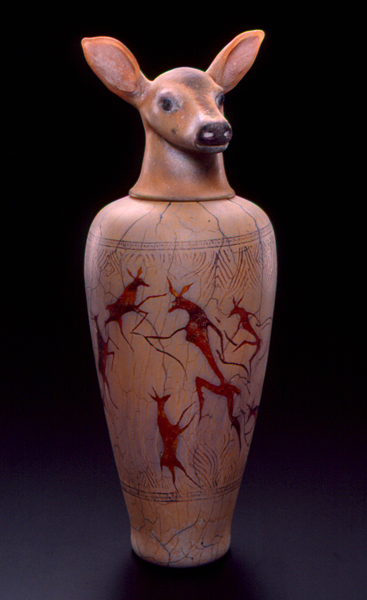
blown glass
31″ x 11″ x 11″
William Morris – The Pioneer
William Morris is a name that resonates deeply within the American Studio Glass movement. Beginning his career in the late ’70s, Morris had the privilege of working alongside Chihuly, an important figure in the American Studio Glass movement. But what sets Morris apart is his unique approach to glass art — an approach that has had a profound impact on those of us who walk the shamanic path.
Morris’s work often draws inspiration from ancient cultures and natural elements. His pieces are more than just beautiful objects; they are stories captured in glass. Whether it’s a series that mimics the texture of ancient artifacts or a sculpture that embodies the spirit of a wild animal, Morris’s art invites us to connect with something greater than ourselves.
Morris’s Influence on Studio Glass
For those of us in the healing arts, Morris’s work serves as a powerful tool for introspection and transformation. His art doesn’t just decorate a space; it changes the energy of that space. When you stand before a piece by Morris, you’re not just an observer; you’re a participant in a sacred dialogue between the art, the artist, and the universe.
His influence extends beyond the studio and into the realm of spiritual practice. Many collectors and healing arts practitioners incorporate shamanic pieces into their work, whether it’s through meditation, energy work, or other therapeutic modalities. The art becomes a conduit for healing energy, amplifying the effects of the practice and enriching the experience for both provider and recipient.
Preston Singletary – The Indigenous Voice
In the ever-evolving world of American Studio Glass, Preston Singletary stands as a lighthouse of cultural richness and artistic mastery. With his Tlingit heritage as the backdrop, Singletary has carved out a unique space in the glass art community, one that resonates deeply with indigenous arts and shamanic practices.
Singletary’s work is a harmonious blend of traditional Tlingit art forms and contemporary glass techniques. His pieces often feature intricate designs and motifs that are deeply rooted in indigenous culture. From totemic figures to ancestral stories, each piece serves as a modern-day relic that honors the wisdom and spirituality of the Tlingit people.
Shamanic Resonance and Craftsmanship
What makes Singletary’s work especially compelling for those of us on a shamanic path is the spiritual depth embedded in his art. His pieces are not merely decorative; they are imbued with intention and meaning. When you encounter a Singletary creation, you’re invited into a sacred narrative — one that has the power to awaken your own spiritual insights.
For practitioners in the healing arts, Singletary’s work offers a unique avenue for enhancing visionary experiences. Whether it’s a piece that graces the walls of a healing space or a sculpture that serves as the focal point for meditation, his art becomes an active participant in the healing process. The intricate designs and cultural motifs act as visual mantras, aiding in focus and introspection.
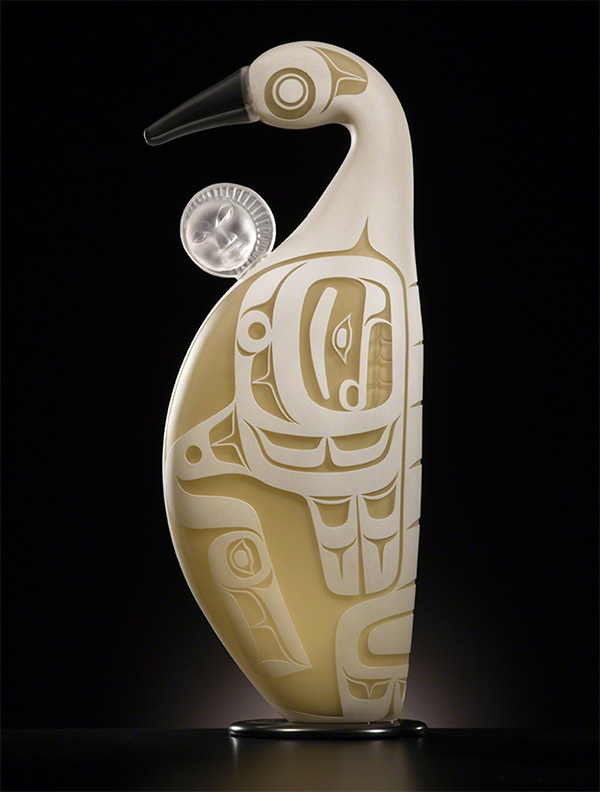
blown and sand-carved glass
22.75″ x 8.5″ x 2.5″
Contributions to the Healing Arts
Morris and Singletary’s influence extends beyond their studios, impacting the spheres of healing and spirituality. Their art is highly valued by indigenous communities, shamanic healers, and other artists, who integrate it into their collections and therapeutic practices.
Their art forms a link between the physical and spiritual, blending ancient traditions with contemporary styles. Among art collectors, a Morris creation often sparks discussions on ancestral knowledge and heritage. In meditation circles, Singletary’s works become catalysts to deeper spiritual inquiries.
For those transitioning from hot glass to healing arts and returning, their creations vividly illustrate the unity of all aspects of life. These sculptures show that beauty and spirituality are inseparably woven into our very being.
Venetian-Style Influences
The Maestros Who Shaped American Studio Glass Art
The American Studio Glass movement has been deeply enriched by Venetian-style hot glassblowing techniques. This centuries-old tradition from the glassmaking islands of Venice, Italy, has found a second home in the United States, thanks to the contributions of several maestros. Among them, Lino Tagliapietra, William Gudenrath, and the father-son duo of Paul and Dante Marioni have left an indelible mark on the art form. Their influence extends to those of us who have transitioned from hot glassblowing to the healing arts.
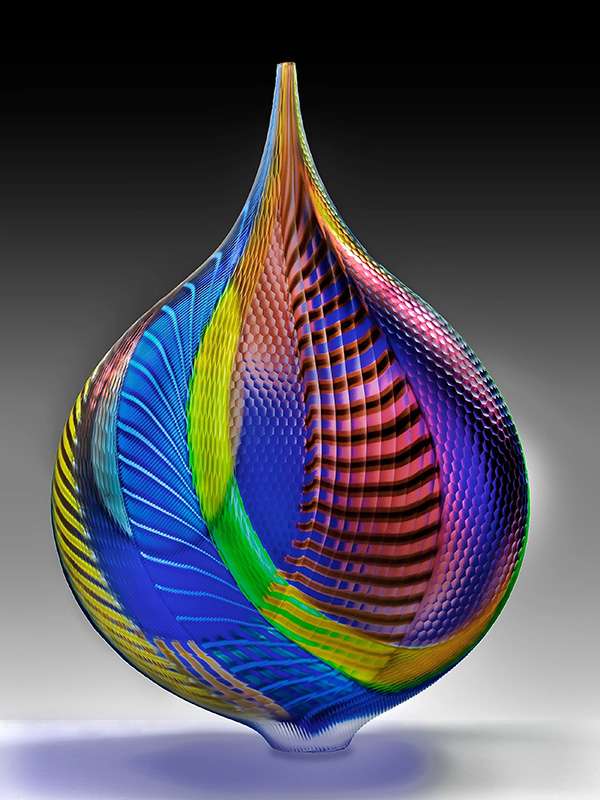
blown glass
24.25″ x 17″ x 8″
Lino Tagliapietra – The Maestro
Lino Tagliapietra is a living legend in the world of glass art. His mastery of Venetian techniques has not only elevated his own work but has also inspired a generation of American glass artists. Tagliapietra’s pieces often feature intricate patterns and vibrant colors, capturing the essence of Venetian artistry while adding a contemporary flair. For those of us in the healing arts, his work serves as a visual symphony, harmonizing color, form, and energy into a cohesive whole.
In addition to his artistic prowess, Tagliapietra is a dedicated mentor and educator. He has conducted workshops and masterclasses around the world, sharing his expertise and passion for glass art with emerging artists. This commitment to education has created a ripple effect, enriching the global glass art community and ensuring that the Venetian techniques he has mastered continue to thrive and evolve.
Tagliapietra’s influence also extends to the realm of public art and installations. His large-scale works often grace public spaces, museums, and galleries, serving as focal points that invite communal appreciation and contemplation. These installations are not just visually captivating; they also create an atmosphere that encourages mindfulness and spiritual reflection, making them an integral part of spaces dedicated to healing and wellness.
William Gudenrath – Venetian Mastery
William Gudenrath, a renowned figure in the American Studio Glass movement, is particularly celebrated for his expertise in Venetian glassmaking techniques. As a resident advisor at the Corning Museum of Glass, Gudenrath has played a pivotal role in both preserving and advancing the art of glassmaking.
Gudenrath’s journey in glass began with a deep fascination for the material and its endless possibilities. Over the years, he has honed his skills, particularly focusing on the replication of historical glass pieces, which has allowed him to delve deeply into the techniques and styles of ancient glassmakers. His work is not just about creating beautiful objects; it’s about connecting with the history and tradition of glassmaking.
Glassmaking Historian
At the Corning Museum of Glass, Gudenrath has been instrumental in the development of educational programs. He is known for his engaging teaching style, combining hands-on demonstrations with rich historical context. His workshops and classes have inspired countless artists and enthusiasts, fostering a new generation of glassmakers who are well-versed in traditional techniques.
Moreover, Gudenrath’s contributions extend to his scholarly work. He has conducted extensive research on historical glassmaking techniques, contributing valuable insights to the field. His studies often focus on the replication of historical glass artifacts, offering a tangible connection to the past. Through his research, he has helped to unravel the mysteries of ancient glassmaking, making these techniques accessible to modern artists.
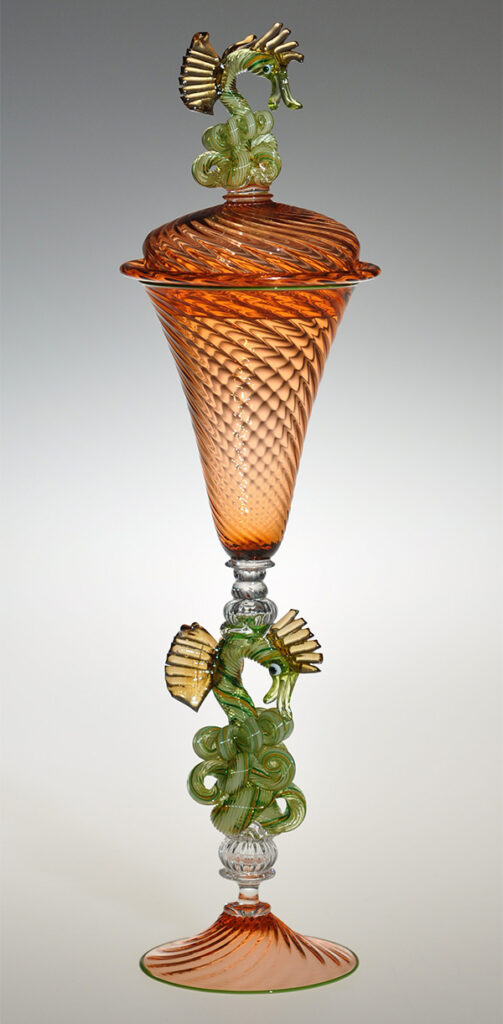
blown glass
11″ +
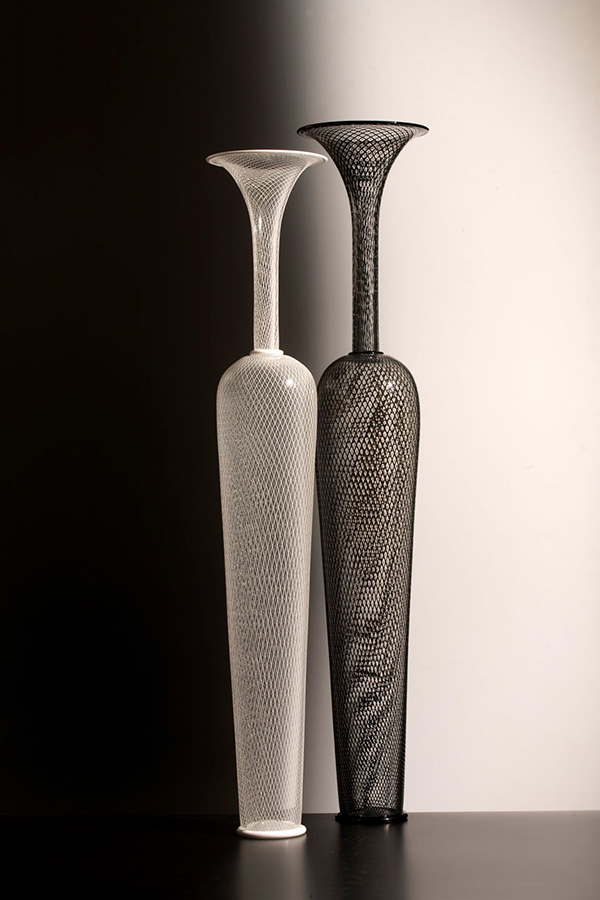
blown glass
30″ +
Dante Marioni – The Modernist
Dante Marioni holds a significant place in the American Studio Glass movement, particularly known for his large-scale works that manage to be both grandiose and intricately detailed. Born into an artistic family, Dante was introduced to the world of glass at a young age by his father, Paul Marioni. A renowned artist in his own right, Paul Marioni was instrumental in shaping Dante’s early understanding and respect for the art form. His father’s teachings went beyond mere technique; they instilled in Dante an appreciation for the emotional and intellectual depths that glass art could reach.
Paul Marioni’s influence acted as a kind of artistic compass for Dante. It guided him through his formative years and helped him navigate the landscape of artistic expression. This early exposure to glass art provided Dante with a rich soil in which to plant his own creative seeds. As he matured as an artist, Dante began to incorporate his own vision into the lessons he had absorbed from his father, evolving into a style that was distinct yet deeply rooted in a family legacy. His pieces often exude a remarkable balance of audacity and craftsmanship, echoing his father’s philosophies while showcasing his own unique techniques.
Eric Meek – The Educator
Eric Meek holds a special place on my path. I first met him as an undergraduate student at Kent State University’s hot glass program, where he was one of my earliest mentors. Today, he serves as the Senior Manager of Hot Glass Programs at the Corning Museum of Glass. Eric’s approach to teaching is as fluid and adaptable as the glass he shapes, making him an invaluable guide for those new to the art form.
His influence extends beyond the technical aspects of glassblowing. Eric has a knack for imbuing his teachings with a sense of wonder and curiosity. Whether it’s a beginner’s workshop or an advanced masterclass, students leave his sessions not just with improved skills, but also with a deeper connection to the art and themselves.
The Venetian-style influences in American studio glass art are a testament to the global and timeless appeal of this craft. As we journey from hot glass to healing arts and back again, the work of these maestros serves as both inspiration and affirmation. They remind us that art is not just a solitary endeavor but a collaborative dialogue that spans cultures, disciplines, and even dimensions.
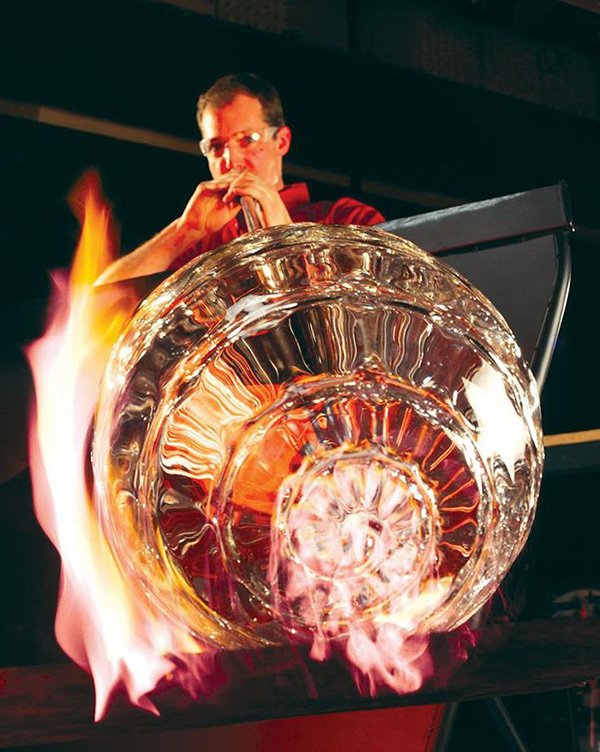
Corning Museum of Glass
Educational Opportunities in Hot Glass – Nurturing the Artist and Healer Within
For those of us who have ventured from the world of hot glass into the healing arts and are now making our way back, education plays a crucial role. Whether you’re a seasoned artist looking to refine your skills or a practitioner seeking to incorporate glass art into your practice, there are several institutions that offer invaluable resources and training. Let’s explore some of these educational havens that nurture both the artist and the healer within us.
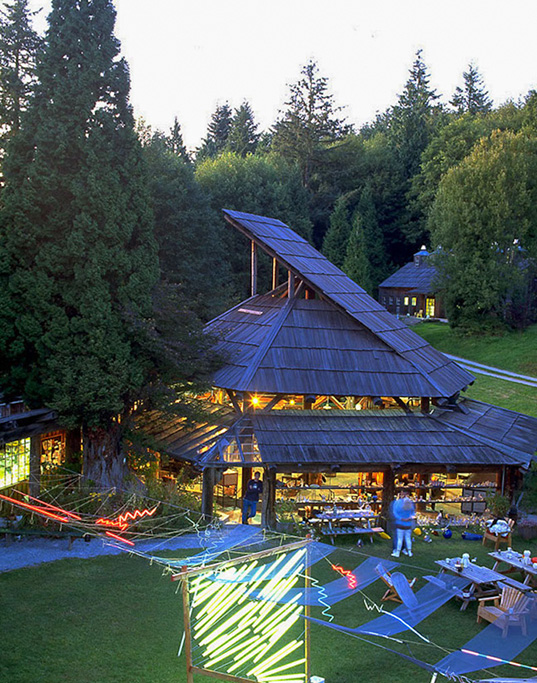
Pilchuck Glass School
Stanwood, WA
Situated in the lush forests of Washington State, the Pilchuck Glass School is another haven for aspiring glass artists. Founded by Dale Chihuly, Ruth Tamura, and patrons Anne and John Hauberg, Pilchuck has been at the forefront of innovation in glass art. The school offers a unique curriculum that combines traditional techniques with contemporary artistic visions. For those interested in the intersection of art and spirituality, Pilchuck provides a fertile ground for exploration.
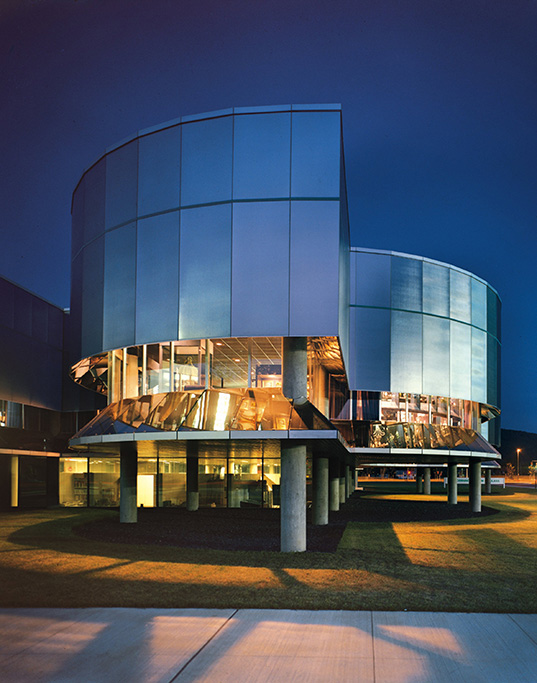
Corning Museum of Glass
Corning, NY
Located in Corning, New York, the Corning Museum of Glass is a treasure trove for glass enthusiasts. Not only does it house an extensive collection of glass art, but it also offers a range of educational programs. From beginner workshops to advanced masterclasses, the museum provides a comprehensive learning experience. And let’s not forget its role in fostering a sense of community among artists, educators, and enthusiasts alike.
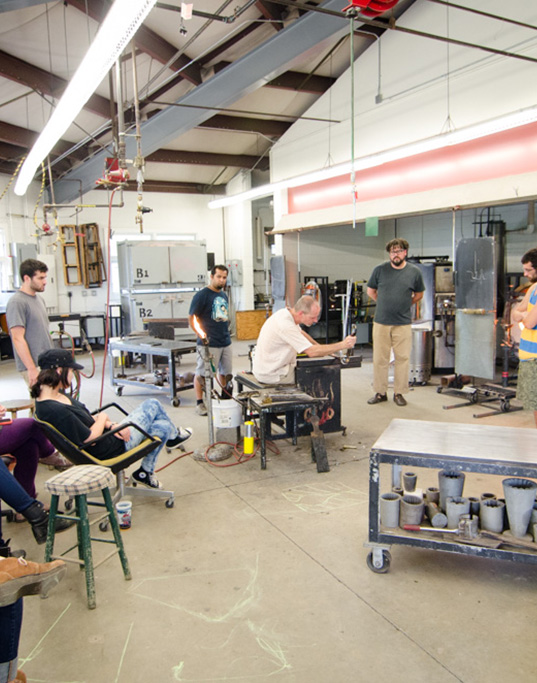
Penland School of Craft
Penland, NC
Closer to home for those of us based in North Carolina, the Penland School of Craft offers an immersive experience in the world of hot glass. Nestled in the scenic Blue Ridge Mountains, Penland provides a tranquil setting that’s perfect for artistic exploration and spiritual growth. The school offers a variety of courses, from short workshops to intensive residencies, allowing you to choose the educational path that best suits your needs.
American Craft Council, MN
Based out of Minneapolis, Minnesota, the American Craft Council is a national nonprofit that advocates for the craft community. While not a traditional educational institution, the Council offers a plethora of resources, including publications, exhibitions, and events that serve to educate and inspire. For those of us in the healing arts, the Council’s focus on the transformative power of craft resonates deeply with our own beliefs in the healing potential of art.
As we journey back to our roots in hot glass, these educational opportunities offer more than just technical skills; they offer a space for personal and spiritual growth. Whether it’s the community-centric environment of the Corning Museum, the natural beauty of Penland, the innovative spirit of Pilchuck, or the advocacy work of the American Craft Council, each institution contributes to our holistic development as artists and practitioners.
The Transformative Journey from Hot Glass to Healing Arts and Back
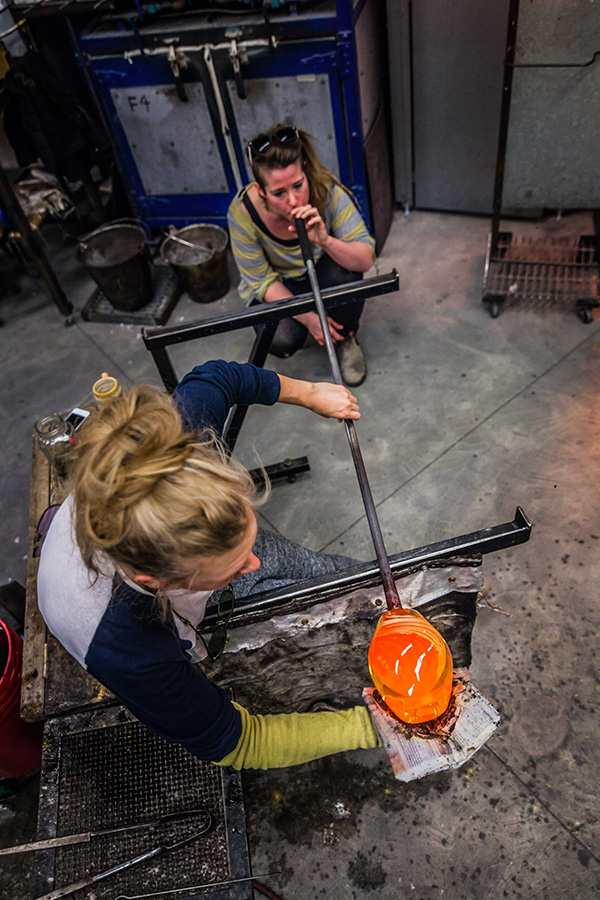
The Circle Completes
As we come full circle, returning to the world of hot glass after a transformative journey through the healing arts, it’s essential to pause and reflect. The artists and educational institutions we’ve explored in this series serve as waypoints on a path that is both artistic and spiritual. Each has contributed to our understanding of how hot glass can be more than just an art form; it can be a medium for healing, introspection, and spiritual growth.
The Influence of Artists
Artists like Dale Chihuly, William Morris and Preston Singletary have shown us that glass art can be a powerful tool for shamanic and healing practices. Their work transcends the boundaries of traditional art, inviting us into a deeper dialogue with ourselves and the universe. Similarly, the Venetian maestros — Lino Tagliapietra, William Gudenrath, Dante Marioni, and Eric Meek — have enriched the American Studio Glass movement, adding layers of complexity and spiritual depth.
The Role of Education
Educational opportunities, too, play a crucial role in this journey. Institutions like the Corning Museum of Glass, Penland School of Craft, Pilchuck Glass School, and the American Craft Council offer more than just technical training. They provide a nurturing environment where we can explore the intersections between art, healing, and spirituality. These institutions remind us that the pursuit of mastery in hot glass is also a journey toward self-discovery and spiritual enlightenment.
The Healing Arts and Hot Glass
For those of us who have ventured into the healing arts, the return to hot glass is not a step backward but a continuation of our spiritual journey. The skills and insights gained from healing practices can enrich our artistic endeavors, adding layers of meaning and intention to each piece we create. Conversely, the discipline and creativity required in hot glass can enhance our healing work, making us more effective practitioners.
The Path Forward
As we move forward, let’s carry with us the wisdom and inspiration gleaned from these remarkable artists and institutions. Let’s continue to explore the synergies between hot glass and the healing arts, recognizing that each enriches the other in a beautiful, cyclical dance. And most importantly, let’s remain open to the endless possibilities that lie ahead, knowing that the journey is far from over.
Final Thoughts
Whether you’re an artist, a bodyworker, or someone who straddles both worlds, the American Studio Glass movement offers a rich tapestry of opportunities for growth and transformation. As we’ve seen, this art form is not just about creating beautiful objects; it’s about shaping a more conscious, connected, and spiritually enriched life.
